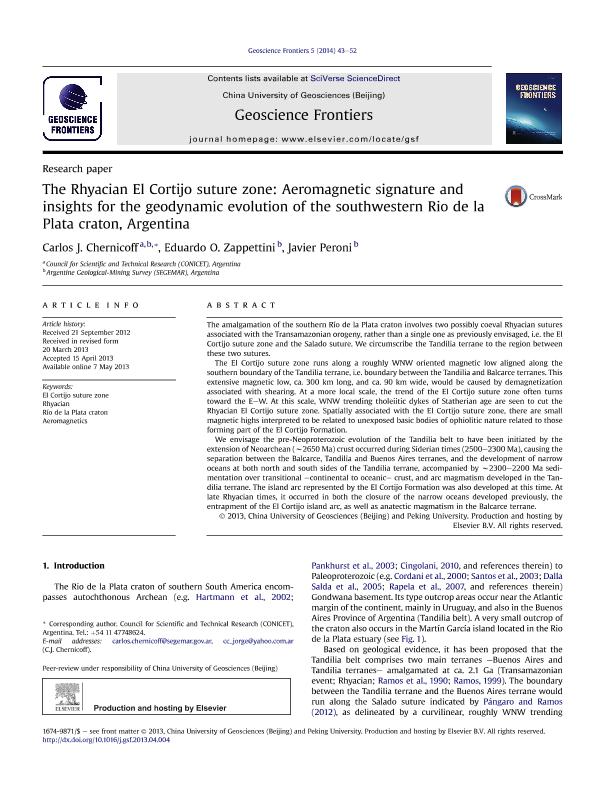Mostrar el registro sencillo del ítem
dc.contributor.author
Chernicoff, Carlos Jorge

dc.contributor.author
Zappettini, Eduardo Osvaldo

dc.contributor.author
Peroni, Javier Ignacio

dc.date.available
2019-11-13T22:21:25Z
dc.date.issued
2014-01
dc.identifier.citation
Chernicoff, Carlos Jorge; Zappettini, Eduardo Osvaldo; Peroni, Javier Ignacio; The Rhyacian El Cortijo suture zone: Aeromagnetic signature and insights for the geodynamic evolution of the southwestern Rio de la Plata craton, Argentina; Elsevier; Geoscience Frontiers; 5; 1; 1-2014; 43-52
dc.identifier.issn
1674-9871
dc.identifier.uri
http://hdl.handle.net/11336/88824
dc.description.abstract
The amalgamation of the southern Río de la Plata craton involves two possibly coeval Rhyacian sutures associated with the Transamazonian orogeny, rather than a single one as previously envisaged, i.e. the El Cortijo suture zone and the Salado suture. We circumscribe the Tandilia terrane to the region between these two sutures. The El Cortijo suture zone runs along a roughly WNW oriented magnetic low aligned along the southern boundary of the Tandilia terrane, i.e. boundary between the Tandilia and Balcarce terranes. This extensive magnetic low, ca. 300 km long, and ca. 90 km wide, would be caused by demagnetization associated with shearing. At a more local scale, the trend of the El Cortijo suture zone often turns toward the E-W. At this scale, WNW trending tholeiitic dykes of Statherian age are seen to cut the Rhyacian El Cortijo suture zone. Spatially associated with the El Cortijo suture zone, there are small magnetic highs interpreted to be related to unexposed basic bodies of ophiolitic nature related to those forming part of the El Cortijo Formation. We envisage the pre-Neoproterozoic evolution of the Tandilia belt to have been initiated by the extension of Neoarchean (∼2650 Ma) crust occurred during Siderian times (2500-2300 Ma), causing the separation between the Balcarce, Tandilia and Buenos Aires terranes, and the development of narrow oceans at both north and south sides of the Tandilia terrane, accompanied by ∼2300-2200 Ma sedimentation over transitional -continental to oceanic- crust, and arc magmatism developed in the Tandilia terrane. The island arc represented by the El Cortijo Formation was also developed at this time. At late Rhyacian times, it occurred in both the closure of the narrow oceans developed previously, the entrapment of the El Cortijo island arc, as well as anatectic magmatism in the Balcarce terrane.
dc.format
application/pdf
dc.language.iso
eng
dc.publisher
Elsevier

dc.rights
info:eu-repo/semantics/openAccess
dc.rights.uri
https://creativecommons.org/licenses/by-nc-nd/2.5/ar/
dc.subject
AEROMAGNETICS
dc.subject
EL CORTIJO SUTURE ZONE
dc.subject
RHYACIAN
dc.subject
RÍO DE LA PLATA CRATON
dc.subject.classification
Geología

dc.subject.classification
Ciencias de la Tierra y relacionadas con el Medio Ambiente

dc.subject.classification
CIENCIAS NATURALES Y EXACTAS

dc.title
The Rhyacian El Cortijo suture zone: Aeromagnetic signature and insights for the geodynamic evolution of the southwestern Rio de la Plata craton, Argentina
dc.type
info:eu-repo/semantics/article
dc.type
info:ar-repo/semantics/artículo
dc.type
info:eu-repo/semantics/publishedVersion
dc.date.updated
2019-10-28T14:36:11Z
dc.journal.volume
5
dc.journal.number
1
dc.journal.pagination
43-52
dc.journal.pais
China

dc.journal.ciudad
Beijing
dc.description.fil
Fil: Chernicoff, Carlos Jorge. Consejo Nacional de Investigaciones Científicas y Técnicas; Argentina. Secretaría de Industria y Minería. Servicio Geológico Minero Argentino; Argentina
dc.description.fil
Fil: Zappettini, Eduardo Osvaldo. Secretaría de Industria y Minería. Servicio Geológico Minero Argentino; Argentina
dc.description.fil
Fil: Peroni, Javier Ignacio. Consejo Nacional de Investigaciones Científicas y Técnicas; Argentina. Secretaría de Industria y Minería. Servicio Geológico Minero Argentino; Argentina
dc.journal.title
Geoscience Frontiers
dc.relation.alternativeid
info:eu-repo/semantics/altIdentifier/doi/https://doi.org/10.1016/j.gsf.2013.04.004
dc.relation.alternativeid
info:eu-repo/semantics/altIdentifier/url/https://www.sciencedirect.com/science/article/pii/S1674987113000571
Archivos asociados
